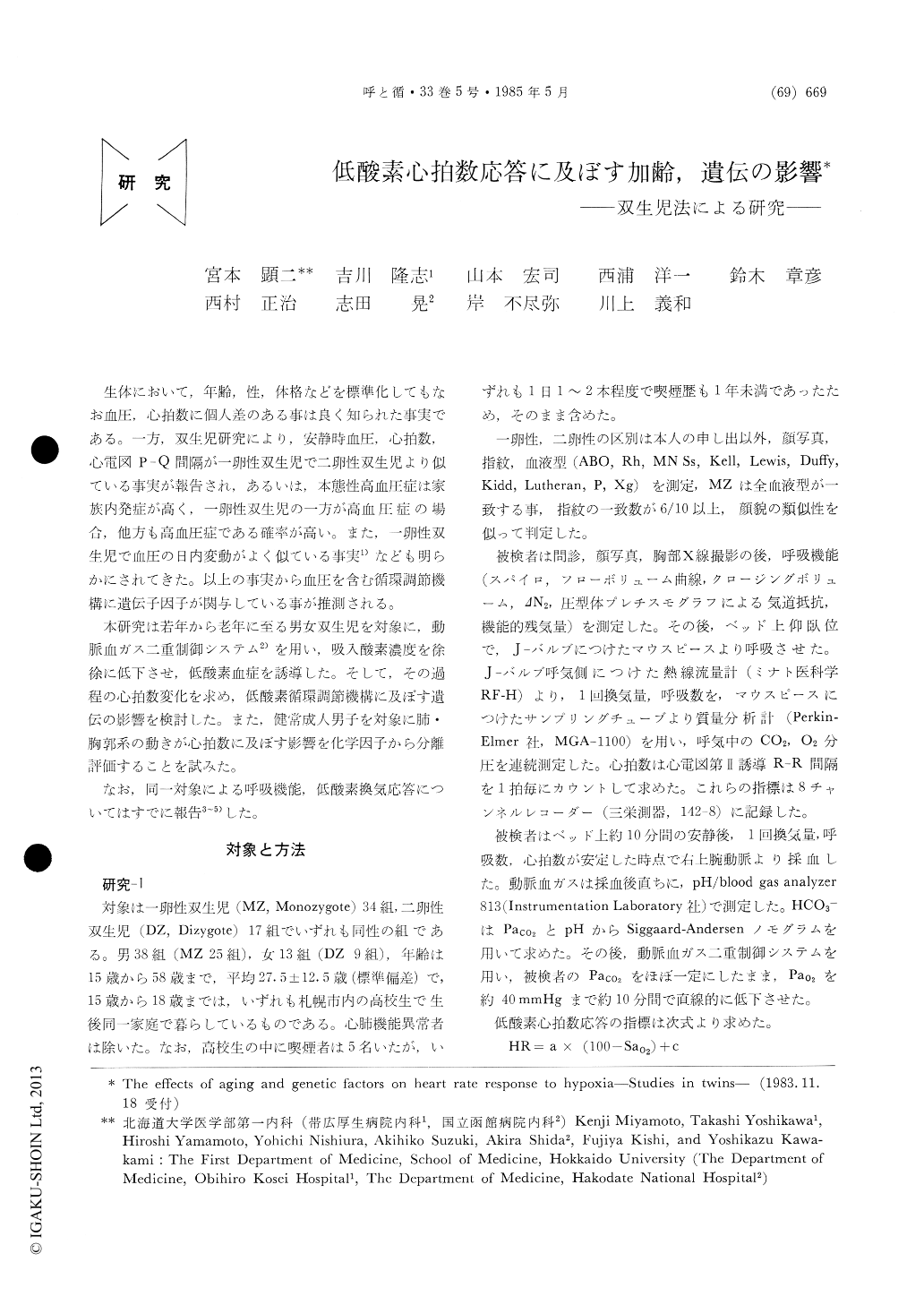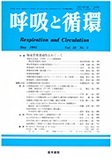Japanese
English
- 有料閲覧
- Abstract 文献概要
- 1ページ目 Look Inside
生体において,年齢,性,体格などを標準化してもなお血圧,心拍数に個人差のある事は良く知られた事実である。一方,双生児研究により,安静時血圧,心拍数,心電図P-Q間隔が一卵性双生児で二卵性双生児より似ている事実が報告され,あるいは,本態性高血圧症は家族内発症が高く,一卵性双生児の一方が高血圧症の場合,他方も高血圧症である確率が高い。また,一卵性双生児で血圧の日内変動がよく似ている事実1)なども明らかにされてきた。以上の事実から血圧を含む循環調節機構に遺伝子因子が関与している事が推測される。
本研究は若年から老年に至る男女双生児を対象に,動脈血ガス二重制御システム2)を用い,吸入酸素濃度を徐徐に低下させ,低酸素血症を誘導した。そして,その過程の心拍数変化を求め,低酸素循環調節機構に及ぼす遺伝の影響を検討した。また,健常成人男子を対象に肺・胸郭系の動きが心拍数に及ぼす影響を化学因子から分離評価することを試みた。
We studied the role of genetics and environmental factors determining heart rate response to isocap-nic hypoxia (study-1), and the effect of pulmonary inflation reflex, which is activated by the increases in ventilation induced by chemoreceptor stimulation (study-2).
Study-1 51 pairs of twins (34 MZ and 17 DZ) of both sexes, ranging in age from 15 to 58 years, were used as subjects. Heart rate response (4HR/dSaO2) was determined by a dual control system developed to automatically attain isocapnic hypoxia. Hy-poxic ventilatory response (A) was also determined. The variable ΔHR/ΔSaO2 was assessed by the lin-ear equation ; HR=HRo+ΔHR/ΔSaO2 (100-SaO2), The range of ΔHR/ΔSaO2 was 0.257-2.223 (mean ±SD=1.011±0.493) beats/min/1% fall in SaO2. Heart rate response to hypoxia diminishes with age (r=-0.540 p<0.05). There is no relationship between ΔHR/ΔSa.02 and body size. To evaluate genetic factors that have effect on the heart rate response to hypoxia, we separated the twins into two groups, young twin group and adult twin group. Young twin group (15-18 yrs) consisted of high school students who were living together in the same family since their birth. Adult twin group (26-58yrs) consisted of twins who were living separately because of marriage, employment or other reasons. In the young twin group, intrapair variance for ΔHR/ΔSa02 was sig-nificantly smaller in MZ than in DZ. In the adult twin group, intrapair variance was not significant between MZ and DZ.
Study-2 Six healthy male subjects (aged 21-31 yrs) entered this study to evaluate the effect of pul-monary inflation reflex during progressive isocapnic hypoxia. The subjects were allowed to breathe spon-taneously during hypoxia (free-breathing test). After 10 minute's rest, they maintained the pre-test levelof ventilation by watching an occiloscope screen dis-playing a tidal volume and by listening to the sound of a metronome during progressive hypoxia (control-led-breathing test).
In both tests, we determined ΔHR/ΔSaO2. ΔHR/ΔSaO2 of free-breathing test is 0.841±0.254 (mean ±SD) beats/min/1% fall in SaO2. ΔHR/ΔSaO2 of controlled-breathing test is 0.716±0.199. There was on significant difference in heart rate response between the tests.
These results suggest : 1) Heart rate response to hypoxia diminishes with age and is not related to body size. 2) Heart rate response to hypoxia is, at least partially, under the influence of genetic factors. 3) The occurance of tachy-cardia during progressive hypoxia does not depend on the ventilatory response to chemoreceptor stimula-tion.

Copyright © 1985, Igaku-Shoin Ltd. All rights reserved.


